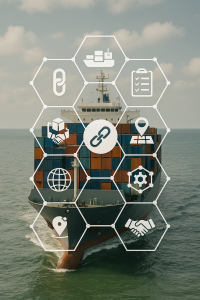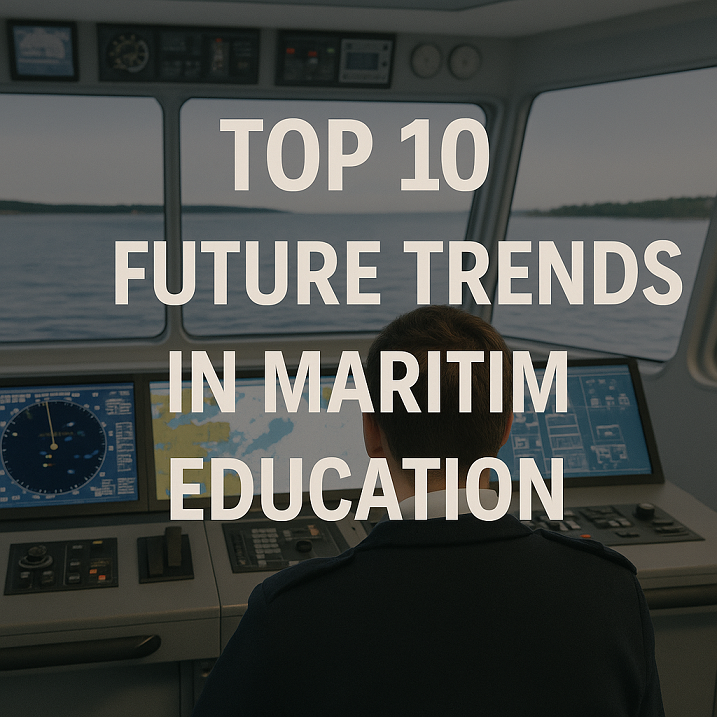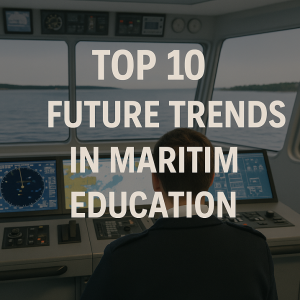Discover the top 10 future trends in maritime education that are redefining how seafarers learn. From simulation to sustainability, explore the innovations preparing the next generation of maritime professionals.
Why Maritime Education is Evolving in the 21st Century
The maritime industry is undergoing a once-in-a-generation transformation. Driven by digitalization, decarbonization, and regulatory shifts, modern shipping demands more than traditional seamanship. Today’s maritime professionals must navigate automated systems, alternative fuels, cybersecurity threats, and dynamic trade patterns—requiring new skills, new tools, and new methods of learning.
As the International Maritime Organization (IMO) sharpens its regulatory lens and shipping companies race to adopt cutting-edge technologies, maritime education must keep pace. That means moving beyond the chalkboard and chart table to embrace immersive simulations, AI-driven analytics, and competency-based learning.
In this article, we explore the top 10 future trends shaping maritime education, backed by expert insights, real-world applications, and a vision for what’s ahead.
1. Immersive Simulation-Based Training
Simulation has long been part of maritime training—but the future is hyper-realistic, fully immersive, and scenario-driven. New platforms combine VR (Virtual Reality) and AR (Augmented Reality) to recreate high-pressure environments—storms, port operations, equipment failures—without risking safety or equipment.
Benefits:
-
Enhanced decision-making under stress
-
Safer training for hazardous operations
-
Standardized assessment of competencies
Example: Kongsberg Digital’s K-Sim Navigation platform replicates full mission bridge operations, enabling team-based training and individual assessment.
2. AI and Big Data in Competency Tracking
Maritime education is shifting from hours-based certification to competency-based training. Powered by AI and big data, platforms can now:
-
Track individual learner performance in real time
-
Predict skill gaps
-
Recommend personalized learning pathways
Future Outlook: AI tutors may soon guide cadets through virtual engine rooms, providing real-time feedback on every valve turned or alarm acknowledged.
Regulatory Note: The IMO’s STCW amendments may soon recognize AI-enhanced training under “equivalent methods of assessment.”
3. Remote Learning and E-Learning Platforms
COVID-19 accelerated the adoption of remote maritime training, and the trend has only grown. Today’s e-learning platforms offer:
-
Flag-state-approved certificate courses
-
Video modules, quizzes, and instructor feedback
-
SCORM-compliant LMS integration for shipping companies
Platforms to Watch:
-
Marlins eLearning (for English, safety, and soft skills)
-
Videotel (IMO-compliant CBTs)
-
Marine Learning Systems (custom LMS for fleet-wide deployment)
Accessibility Wins: Seafarers can now earn certificates at sea or during leave, closing skill gaps without waiting for port-based classes.
4. Cybersecurity Awareness as Core Curriculum
As ships become more connected, cybersecurity is no longer an IT-only issue. Phishing, ransomware, and GPS spoofing threaten every vessel.
Future-ready maritime curricula are integrating:
-
Ship-specific cyber threat simulations
-
Cyber hygiene basics for all ranks
-
Role-based access and incident response training
IMO Requirement: Since 2021, cyber risk management is mandatory under the ISM Code, pushing MET institutions to embed cyber awareness in all syllabi.
5. Decarbonization and Green Shipping Modules
From LNG and hydrogen to ammonia and battery-electric propulsion, shipping’s energy transition is underway. Maritime education must now prepare seafarers to:
-
Operate alternative fuel systems
-
Monitor emissions under CII and EEXI metrics
-
Implement fuel-saving behaviors
Example: DNV’s Maritime Academy now offers short courses on low-carbon operations, compliant with IMO’s decarbonization strategy.
Analogy: Just as engineers once learned to handle steam, today’s cadets must understand hybrid grids, cold ironing, and exhaust scrubbers.
6. Gamification for Skill Retention
Gamification adds competitive, reward-based learning elements to boost retention and engagement. Features include:
-
Scenario-based challenges
-
Leaderboards and badges
-
Time-bound quizzes with instant feedback
Case Study: The Ocean Learning Platform introduced gamified learning for safety drills, resulting in 30% higher retention and increased voluntary module completion.
Why It Works: Seafarers often prefer interactive over passive content—especially in long voyages or remote deployment.
7. Soft Skills and Cultural Competency Training
The future seafarer must lead diverse, multicultural crews and handle stressful, high-stakes decisions. As automation reduces manual roles, human interaction skills become more critical.
Modern programs now include:
-
Conflict resolution
-
Leadership under pressure
-
Emotional intelligence
-
Cross-cultural communication
ICS Insight: Human error still accounts for 75% of maritime incidents. Emotional and interpersonal competencies can reduce risk across the board.
8. Interdisciplinary and Multi-Modal Curricula
As the lines blur between engineering, navigation, and IT, maritime education is shifting to interdisciplinary frameworks.
Key Shifts:
-
Deck cadets learning about power systems
-
Engineers gaining awareness of bridge operations
-
Inclusion of legal, environmental, and digital fluency
IMO’s Vision: The “seafarer of the future” must understand holistic ship systems, not just their departmental silos.
9. Blockchain and Credentialing Innovation
Paper certificates are vulnerable to forgery, loss, and delays. The future is tamper-proof, blockchain-verified digital credentials.
Benefits:
-
Real-time verification by port authorities and employers
-
Reduced admin and fraud
-
Integration with HR and compliance platforms
Global Trends: Panama, Singapore, and Liberia are piloting digital seafarer ID systems, paving the way for IMO standardization.
10. Sustainability-Driven Career Pathways
As shipping decarbonizes and digitizes, maritime careers are evolving. New pathways include:
-
Environmental officers
-
Maritime data analysts
-
Hydrogen system technicians
-
Remote operations managers
Educational Impact: MET institutions are forming partnerships with clean-tech firms and NGOs to prepare cadets for green maritime careers, beyond traditional engine room roles.

Real-World Case Study: Singapore Maritime Academy’s Digital Leap
Singapore Maritime Academy (SMA) has embraced blended learning with:
-
Full-mission VR engine room simulators
-
Blockchain-verified e-certificates
-
Modular microcredentials for continuous learning
In collaboration with industry players and the Maritime and Port Authority of Singapore (MPA), SMA’s programs reflect not just compliance, but readiness for tomorrow’s seafarers.
FAQ: Maritime Education in the Future
Q1: Will traditional classroom training be replaced by simulation and e-learning?
A: Not entirely. A hybrid approach—combining hands-on, classroom, and digital learning—offers the best outcomes.
Q2: What are the new IMO requirements for maritime training?
A: Since 2021, cyber risk awareness must be part of Safety Management Systems. Future STCW revisions may mandate training on green fuels and AI tools.
Q3: Can cadets earn certificates online?
A: Many theoretical courses and refreshers are available online, but practical training still requires onboard time and simulator assessments.
Q4: How will AI impact maritime teaching?
A: AI will personalize learning, identify gaps, and automate assessments—making training more adaptive and efficient.
Q5: Are seafarers prepared for green technologies like hydrogen and ammonia?
A: Not yet fully. Institutions are quickly developing training around alternative fuels, but widespread readiness will take time.
Conclusion
The future of maritime education is digital, decentralized, and dynamic. As ships grow smarter and more sustainable, training must reflect that complexity—equipping seafarers with not just technical proficiency, but resilience, adaptability, and leadership.
From simulation-based learning to blockchain-based certification, the trends reshaping maritime education are not on the horizon—they’re already at the dock.
Call to Action: Explore next-gen learning resources, training modules, and course catalogs at our Maritime Education Innovation Hub.
References
-
International Maritime Organization. (2021). Guidelines on Maritime Cyber Risk Management. https://www.imo.org
-
ICS. (2022). Future Skills and Training for Seafarers. https://www.ics-shipping.org
-
DNV. (2023). Maritime Academy Courses on Decarbonization. https://www.dnv.com
-
BIMCO. (2022). Digital Training in the Maritime Industry. https://www.bimco.org
-
Singapore Maritime Academy. (2023). Digital Learning and Simulator Capabilities. https://www.sp.edu.sg/sma



Thanks!